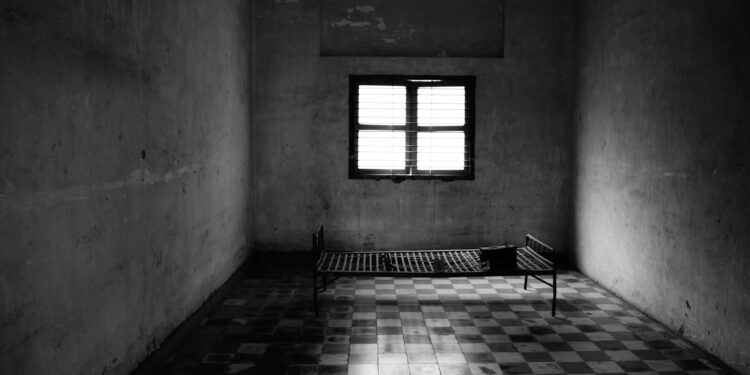California could face more than $40 million in fines after it failed to improve suicide prevention measures in state prisons despite a federal judge’s warning that she would impose financial penalties for each violation.
Chief U.S. District Judge Kimberly Mueller told state officials over a year ago that she would start imposing fines unless they implemented 15 suicide prevention protocols that had been lacking for nearly a decade.
But court expert Lindsay Hayes reported March 1 that the state continues to lag on 14 of the 15 safeguards. The state even regressed in such areas as failing to house prisoners in suicide-resistant cells when they are first placed in segregation, often including solitary confinement, in which prisoners are particularly vulnerable. The special cells lack hooks, wire grates, or other protrusions from which prisoners can hang themselves, for instance.
Suicides have long been a problem in California prisons and are considered a bellwether of a broader, decades-long lack of adequate prison mental health care. They are one of several ongoing issues at the center of a class-action federal lawsuit that dates to 1990.
“Mr. Hayes’ finding of backsliding with respect to some of the remaining recommendations is deeply concerning, particularly in light of the nine years that have passed since he initially offered these recommendations,” wrote Matthew Lopes Jr., the special master retained by Mueller to help oversee prison mental health care.
California Department of Corrections and Rehabilitation spokesperson Pedro Calderón Michel said officials are reviewing the report and will file a formal response April 2. He said the department has a robust suicide prevention program, which has expanded since 2020. A team of psychologists follows a guidebook on suicide prevention practices modeled after the monitoring done by the special master’s own experts. Additionally, that team provides real-time feedback, and the department reviews each suicide.
“The health and well-being of every person in our care are of the utmost importance,” Calderón Michel said.
And as the state continues to experience a shortage of mental health care providers, he said, the department has taken steps to expand the use of telepsychiatry, as well as increasing salaries and benefits to attract more workers.
Thirty California state prisoners died by suicide last year. That’s an increase from 20 suicides in 2022 and 15 in 2021 but fewer than in the preceding two years. California’s rate of 32 suicides per 100,000 prisoners in 2023 exceeded the most recently available national state prison rate of 27 per 100,000.
Hayes’ report included eight instances in which prisoners’ bodies were not discovered until rigor mortis had set in, a stiffening of the joints and muscles that occurs several hours after death. Some of those prisoners were supposed to be monitored regularly to make sure they did not harm themselves; the delay in discovering their deaths cast doubt on whether they were being checked adequately.
In another case, a prisoner was supposed to be under constant suicide watch after he twice tried to kill himself the same day that he sent farewell notes to family members. Yet he was allowed to keep his tennis shoes against the chief psychiatrist’s orders, and he was placed unmonitored in a standard cell instead of a suicide-resistant cell.
An hour later, he was found hanging from the upper bunk by a shoestring.
“You realize this is not a game, these are human beings,” said Michael Bien, an attorney representing prisoners in the lawsuit. “Certainly, you shouldn’t be making the same mistakes that are preventable and foreseeable again and again and again.”
Mueller in a February 2023 order said she would impose $1,000 daily fines starting April 1, 2023, for each unmet safeguard at each prison that failed to comply. The protocols include such things as suicide prevention training and treatment planning, suicide risk evaluations, using suicide-resistant cells, and checking on susceptible prisoners every 30 minutes.
Hayes and Lopes did not say in their court filings how many fines accumulated. But their court filings contain identical charts outlining how many prisons still failed to meet each of the 15 standards during Hayes’ recent inspections. They tally 124 areas of ongoing noncompliance carrying $1,000 daily fines.
If Mueller levied fines for the 11 months between last April and when Hayes filed his report, they would top $41.5 million. But her order has the daily fines continuing indefinitely, and other variables might affect the total.
“No matter how you calculate it, it’s still going to be a very substantial number,” Bien said.
If Mueller follows previous practice, she will next hold a hearing on Hayes’ report and the pending fines. She has not said what the fines would be used for, but the goal is to encourage a resolution of the ongoing problems, not to punish the state.
Hayes’ report comes as Mueller is already considering collecting fines topping $95 million for state officials’ yearlong failure to hire enough mental health professionals to provide adequate treatment in state prisons.
This article was produced by KFF Health News, which publishes California Healthline, an editorially independent service of the California Health Care Foundation.
KFF Health News is a national newsroom that produces in-depth journalism about health issues and is one of the core operating programs at KFF—an independent source of health policy research, polling, and journalism. Learn more about KFF.
Subscribe to KFF Health News’ free Morning Briefing.















